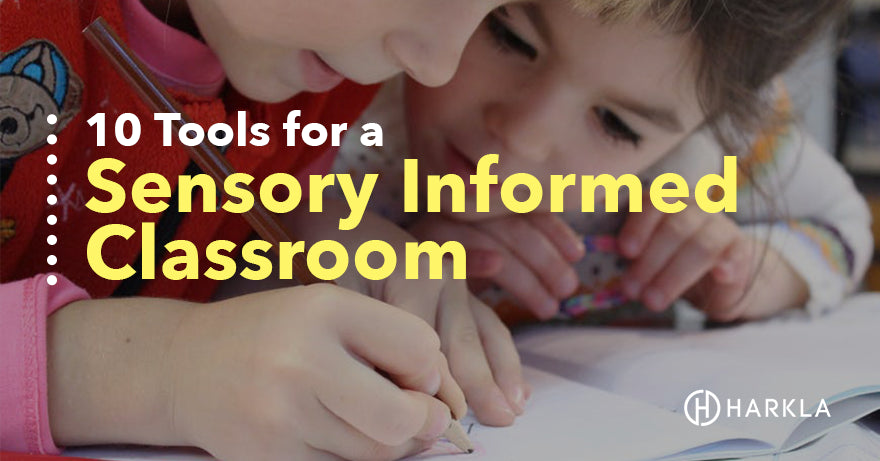Your Cart is Empty

If you’ve got a sensory child who’s of school-age, most likely sensory supports will be needed in the classroom. And if you’re still trying to understand whether your child’s learning or sensory patterns fit into a broader developmental picture, a quick free online autism test can offer a bit of clarity before you meet with the school team.
When talking to teachers and administrators about the need for sensory tools in the classroom, it’s important to frame your discussion in terms of your child’s “readiness to learn.”
Before we get into our top 10 list, take a look at our video on 7 Tips for a Sensory Friendly Classroom. Then, in this blog post, we'll discuss why it's important to have a sensory informed classroom!
Sensory tools are especially useful for supporting sensory-seeking behavior in children. They are intended to promote regulation, improve focus, and increase participation, therefore enabling your child to be available for learning! Some families pair these strategies with rhythmic approaches like music therapy for autism, which can also support emotional and behavioral regulation
The key to a sensory-informed classroom is that it supports the various sensory needs of the students in the classroom in a way that is as natural as possible. Not all students learn the same, nor do they have the same sensory needs. When you include sensory supports or tools in a classroom, they will be used differently by kids depending on what their bodies need, when they need input, and how they choose to use the tools!
No matter how they are used, sensory tools that are naturally embedded into the existing school day are more likely to be used by more than just your sensory child, therefore decreasing the social stigma of needing something “different.”
By creating a sensory-informed classroom, teachers are setting the tone or culture of the classroom to be one of inclusion, acceptance, and differentiation, no matter what the students’ needs are!
The goal of sensory tools in school is to support participation, engagement, and interactions that promote skill development and learning. Whether your child is working to develop social skills with peers, behavioral and emotional regulation, improve attention/focus, develop organization skills, or manage classroom behaviors, sensory tools can regulate a child’s arousal level in order to get at these higher-level skills needed for classroom success!
If you'd like to learn more about how to make sensory breaks work better in the classroom, check out this article.
Below this video, you'll find our top 10 list of sensory tools for school, but we wanted to include this Facebook live session that covers more sensory toolbox ideas and how to implement them at school or home.
6:00 Support your child's OT by integrating activities into your daily routine.
7:30 Toolbox supplies will cover the different sensory systems.
7:40 Vestibular input ideas
9:45 Harkla Sensory Swing
11:40 Scooter Boards are great!
14:30 Body Sock activities
16:06 Vibrating or buzzing massager
18:07 Exercise ball
21:00 Weighted objects
23:00 Fidgets
Did you know that school-aged children need 4-5 hours of movement per day to meet their developing central nervous system’s sensory needs? For some kids, especially those with retained reflexes like the Tonic Labyrinthine Reflex (TLR), movement becomes even more essential for posture, attention, and overall regulation. That’s a hard recommendation to follow when much of their day is spent in school!
 The easiest way to allow for movement in a classroom is to offer students active seating options. “Active seating” is seating that allows for wiggling, moving, and adjusting as an alternative to the typical classroom chair. There are a number of designs to consider:
The easiest way to allow for movement in a classroom is to offer students active seating options. “Active seating” is seating that allows for wiggling, moving, and adjusting as an alternative to the typical classroom chair. There are a number of designs to consider:
Heavy work activities are designed to provide proprioceptive input that has a calming, organizing effect on students. When you put everyday classroom objects (books, lunch bags, recess equipment) into a laundry basket, students can carry/push/pull these heavy baskets for extra doses of proprioceptive input.
Better yet, assigning these heavy work tasks as daily classroom “jobs” will ensure these heavy work activities are embedded into natural classroom routines: chair stacker, library book returner, white-board eraser, recess equipment carrier, door holder!
Check out the American Occupational Therapy Association’s OT Connections Blog for some heavy work chores and activities that are appropriate for home and school.

Manipulatives are often used as a multi-sensory way to teach concepts in school.
If you’ve read our article on fidget toys you know how tactile tools are used as fidgets to help some kids to focus.
Sensory-informed classrooms can incorporate tactile manipulatives and fidgets to support a multitude of students. Consider distraction-free fidgets like pencil top fidgets, bouncy bands on chairs and desks, and set expectations with a classroom poster of fidget rules!
Whether reinforcing math concepts with popsicle sticks or segmenting and blending words with unifix cubes, manipulatives allow for a hands-on approach to new learning. For kinesthetic learners or students who learn best when actively touching, moving, and manipulating materials, these manipulatives make learning happen.
The easiest way to incorporate consistent oral motor sensory inputinto the school day is to look at what you’re sending your child for snacks and lunch. Just as you vary the nutritional contents of those foods you send, you should also be varying the textures, flavors, and consistencies. Chewy, crunchy foods will offer proprioceptive input to the mouth/jaw and offering liquids to suck through a thick straw (i.e. water bottle w thick straw like this) will also require the use of mouth muscles!
 For kids who need more oral input in school, alternative tools allow for sensory modifications in subtle ways.
For kids who need more oral input in school, alternative tools allow for sensory modifications in subtle ways.
When you get your child’s school schedule, take note of the movement opportunities in the form of gym class, specials, and recess. Are those times sufficient to help your child regulate and get a good dose of vestibular input?
If not, you’ll need to look at additional movement opportunities in the form of whole-class activities.
If you’re lucky enough to have a classroom therapy ball, there are a multitude of movement-based sensory breaks using the ball from bouncing to rolling and more!

Weighted objects like weighted lap pads or weighted blankets are a must-have in every classroom for seated tabletop tasks and carpet times! Weighted materials like Harkla’s weighted lap pad offer deep pressure input that has a calming and organizing effect.
Deep touch pressure has been widely studied for its ability to calm the nervous system, reduce stress responses, and help individuals stay more organized and focused. Another OT-recommended approach that offers similar regulating benefits is sensory brushing, a technique used to help calm the nervous system and support better focus.
Some students prefer compression garments worn under regular clothing or compression vestsare worn on top of their clothing. These are student-specific considerations that are appropriate sensory tools for school depending on your preference and your child’s sensory needs.
Click here to visit Harkla's Catalog of Weighted Vests, Blankets, and Lap Pads
Because a classroom can be a noisy, visually overwhelming, overstimulating place for a sensory student, it’s important to have a designated “quiet corner,” especially for children who also experience challenges related to auditory processing disorder, where sound can feel unpredictable or intense. That could be as simple as the reading nook in the corner of the class or as complex as a teepee with a beanbag chair and headphones! Many families use similar ideas at home and create a calming space designed for sensory comfort.
Take a look at the Harkla Hug! It provides a calming place for a child to sit while it applies much-needed pressure to sensitive areas of the body, helping your child feel grounded and in control.
Having an identified sensory deprivation area will allow your child to initiate taking a break when needed, proactively de-escalating when he feels overstimulated.

It’s important to look at visual supports for learning as well as for regulation assistance in a classroom. When visuals are effective, they reduce the amount of verbal direction, reminders, or prompting needed.
For some sensory students, these strategies could make a huge difference in supporting positive classroom behaviors and self-regulation. Visual timers and visual calm-down bottles both offer non-verbal ways of prompting transitions and behavior supports.
For other students, reducing the amount of visual distraction is key to helping them maintain attention and complete classroom tasks. Desktop or tabletop partitions, privacy boards, or “offices” are sometimes all it takes to help a student to focus on his work!

Think back to preschool and kindergarten - so much new learning took place through tactile mediums! Fingerpaint tracing shapes, shaving cream letter writing, even playdoh letter rolling -- using the tactile (touch) sensory system helps some students learn new concepts!
For elementary-aged children, using tactile tools can support continued concept development, so bring out the sand tray, raised line paper, tactile bins, and sensory table. There’s a way to make most new concepts multisensory!
We’ve talked about reducing sensory stimulation with a quiet corner in the classroom, but there are times when auditory information can help sensory students identify transitions and learn new information. Familiar songs, rhymes, and music can prompt students through the routine expectations of the classroom.
We all remember Barney’s Clean Up song, right? Predictable musical prompts, whether they are a song or an instrument like a chime, can ease transitions from preferred to nonpreferred activities.
For the reluctant reader, include audiobooks along with text to draw on auditory interests and strengths. Sometimes, listening to the rhythmic, calming voice of the narrator can help engage a reluctant reader and avoid some behaviors in the classroom.
No matter the type of classroom setting your child is in, or the type of learner he is, there are countless ways to modify the school environment with sensory-informed choices.
For more information on sensory tools for school, check out Adapt & Learn’s Sensory-Informed Classroom Pinterest page.
We at Harkla would love to hear from you about what your sensory-informed classroom is doing to keep all students engaged and learning!
I’m glad you mentioned in the article to maybe have some kind of quiet corner where there could be a beanbag chair and headphones. It’s good to know that having this sensory deprivation area can help a child breath and take a needed break. I wonder if it would be possible to have an area that has a child’s interests in there, like something related to reading or classical music. http://www.learningheadphones.com/
Comments will be approved before showing up.


Haley Silvers
January 07, 2025
I really enjoyed this article and find it to be very relevant. I work as a COTA/L in a private school that services children with communication disorders and have found that sensory regulation is “key” in the classroom. I have transitioned from a lot of traditional sensory diets to implementing more sensory based strategies in the classroom and developed a schedule that was similar to the one that you posted. I also agree that gross movement and familiar sensory songs are very beneficial and comforting to the students, thanks for sharing!